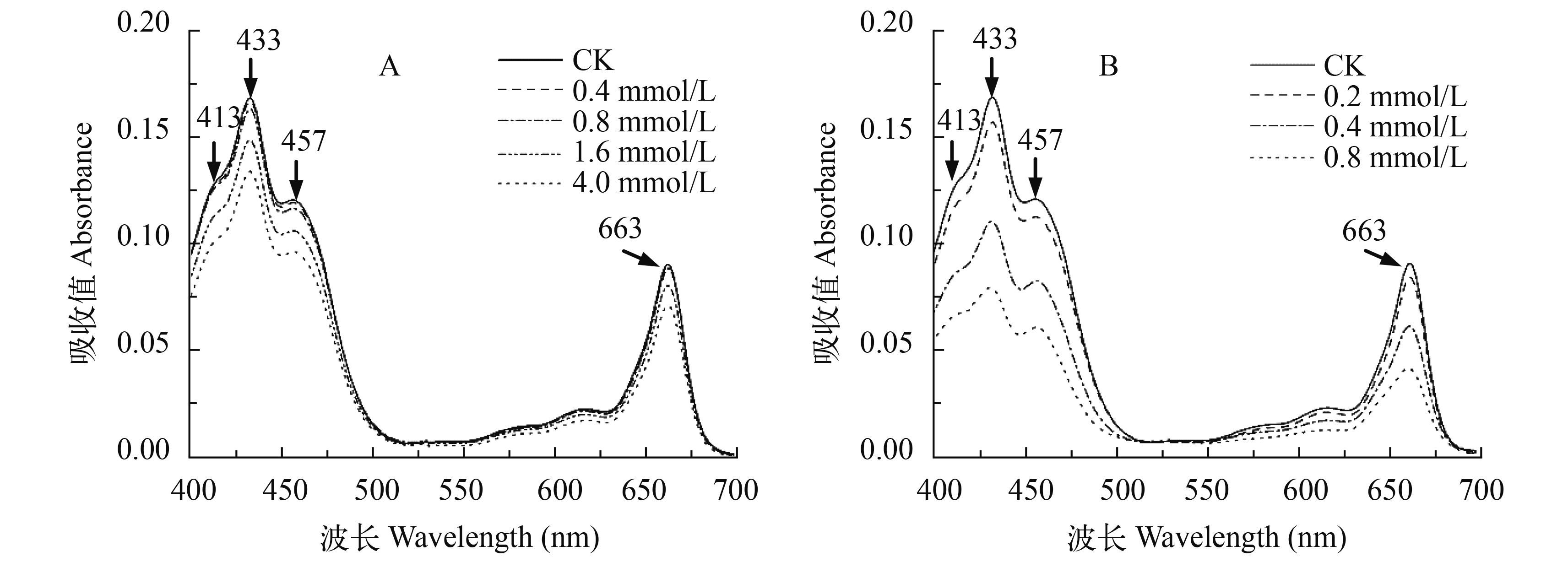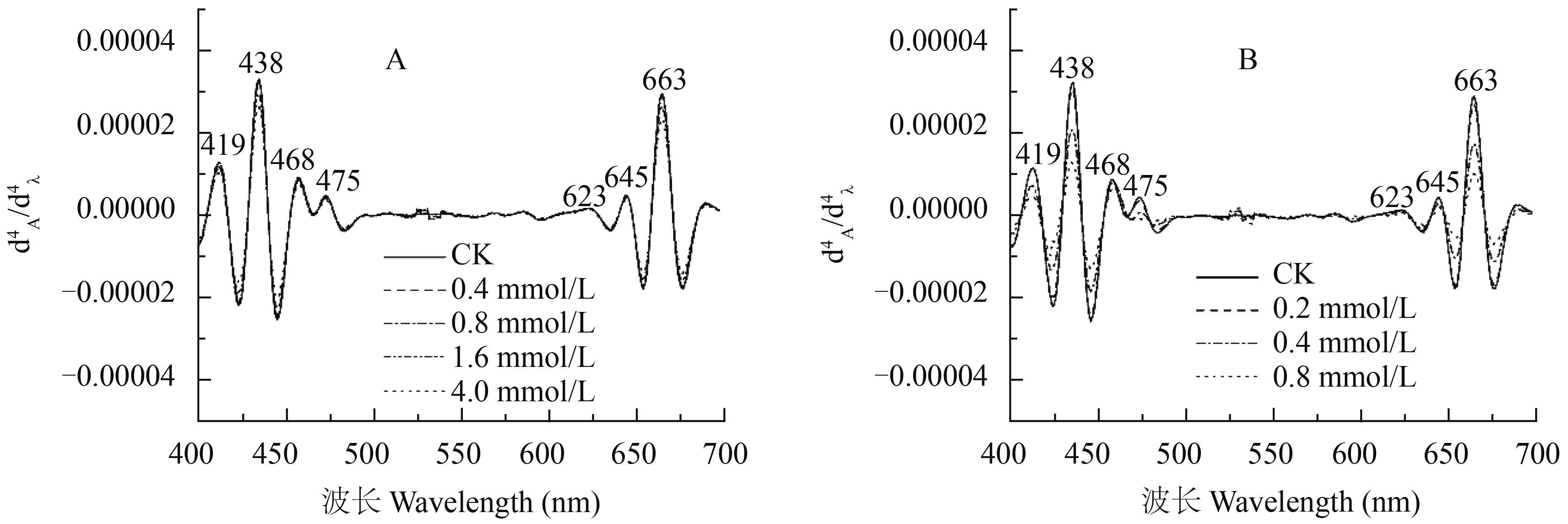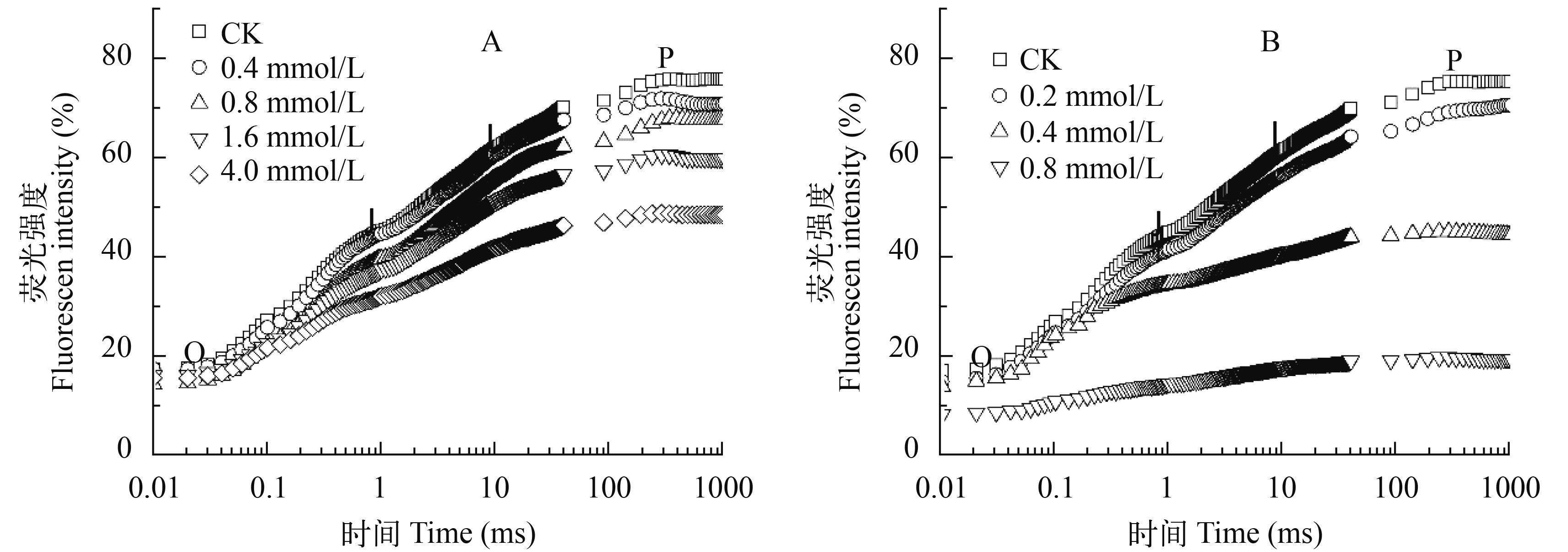EFFECTS OF EUCALYPTOL AND LIMONENE ON THE PHOTOSYNTHETIC ABILITIES IN CHLAMYDOMONAS REINHARDTII
-
摘要: 为了揭示蓝藻挥发性有机化合物(VOCs)中两种主要萜烯类化合物桉树脑和柠檬烯对其他藻类的化感作用,研究了此两种化合物对莱茵衣藻细胞生长、光合素吸收光谱和光合性能的影响。结果表明,莱茵衣藻在1.6和4 mmol/L桉树脑以及0.4和0.8 mmol/L柠檬烯处理24h后,细胞生长受到明显抑制,与对照相比,细胞密度分别降低了16.7%、50.6%、29.1%和44.4%。同时,1.6和4 mmol/L柠檬烯处理会诱导藻细胞全部死亡。此外,莱茵衣藻光合色素在413、433、457和663 nm处的吸收峰均明显降低,光合色素的各成分发生明显降解,叶黄素甚至在0.8 mmol/L柠檬烯处理下完全降解消失。在桉树脑和柠檬烯处理后,莱茵衣藻从O点到P点的荧光强度均低于对照,并且随处理浓度升高而降低。同时,荧光诱导动力学参数中,φPo、Ψo、φEo、RC/CSMS、ABS/CSM、TRo/CSM、ETo/CSM和PIABS均明显降低,而DIo/CSM则明显升高,这表明桉树脑和柠檬烯可抑制莱茵衣藻PSⅡ量子产生和电子传递,并使吸收的光能以热的形式进行耗散。由此可见,桉树脑和柠檬烯可能通过引起其他藻细胞光合色素降解、降低光合性能而发挥化感作用。Abstract: This study investigated the allelopathic effects of eucalyptol and limonene, two main terpenoids from cyanobacteria VOCs, on other algae by focusing on cell growth, absorption spectra of photosynthetic pigments and photosynthetic abilities using Chlamydomonas reinhardtii. Eucalyptol at 1.6 and 4 mmol/L as well as limonene at 0.4 and 0.8 mmol/L remarkably inhibited C. reinhardtii cell growth by 16.7%, 50.6%, 29.1% and 44.4%, respectively. Moreover, limonene at 1.6 and 4 mmol/L killed the cells. In addition, an obvious reduction was found in the absorption peaks at 413, 433, 457 and 663 nm. The components of photosynthetic pigments were degraded markedly, and xanthophyll even disappeared by 0.8 mmol/L limonene treatment. When C. reinhardtii cells were treated by eucalyptol and limonene, the fluorescence intensity from O to P was lower compared to the control, and it was declined with the increased compound concentration. In chlorophyll fluorescence transient parameters, φPo, Ψo, φEo, RC/CSM, ABS/CSM, TRo/CSM, ETo/CSMand PIABS were declined remarkably, while DIo/CSM was raised remarkably, indicating that eucalyptol and limonene can inhibit the quantum production and electron transport in PSⅡ, and promote the absorbed solar energy to dissipate as heat. Therefore, eucalyptol and limonene might play allelopathic effects in cyanobacteria VOCs via inducing degradation of photosynthetic pigments and reducing photosynthetic abilities in other algae.
-
Keywords:
- Allelopathy /
- Eucalyptol /
- Limonene /
- Absorption spectrum /
- Photosynthetic ability
-
-
图 3 桉树脑和柠檬烯对叶绿素4阶导数光谱的影响
419. 二乙烯基脱镁Chl. a; 438. 二乙烯基Chl. a; 468. 二乙烯基Chl. b; 475. 叶黄素; 623. 单乙烯基原叶绿素酸酯a; 645. 单乙烯基Chl. b; 663. 单乙烯基Chl. a
Figure 3. Effects of eucalyptol and limonene on 4th derivative of absorption spectra
419. Divinyl-pheophytin a, 438. Divinyl-chlorophyll a, 468. Divinyl-chlorophyll b, 475. Xanthophyll, 623. Monovinyl-protochlorophyllide a, 645. Monovinyl-chlorophyll b, 663. Monovinyl-chlorophyll a
表 1 桉树脑对莱茵衣藻荧光动力学参数的影响
Table 1 Effects of eucalyptol on chlorophyll fluorescence transient parameters in C. reinhardtii
参数Parameter CK 0.4 mmol/L 0.8 mmol/L 1.6 mmol/L 4 mmol/L φPo 0.76±0.01 0.75±0.01 0.72±0.02 0.71±0.03* 0.68±0.03* Ψo 0.49±0.01 0.47±0.02 0.48±0.03 0.46±0.01* 0.41±0.02** φEo 0.38±0.01 0.36±0.02 0.38±0.02 0.33±0.02** 0.31±0.01** ABS/CSM 76.03±5.97 71.90±6.60 69.73±2.82* 60.40±1.15** 50.65±8.90** TRo/CSM 57.92±4.17 55.41±2.26 53.30±1.98* 43.90±2.90** 35.53±7.93** ETo/CSM 6.78±0.64 6.74±0.07 5.94±0.38* 5.76±0.43** 4.95±0.58** DIo/CSM 17.17±1.89 17.45±0.84 19.37±0.83* 21.14±1.30** 25.81±1.34** RC/CSM 23.06±1.59 22.35±3.21 21.67±1.42 18.32±1.32** 13.65±3.24** PIABS 0.94±0.07 0.90±0.10 0.87±0.07 0.66±0.10** 0.61±0.12** 注: CK. 对照; *. 在24h时与对照相比, 差异在P<0.05水平上显著; **. 在24h时与对照相比, 差异在P<0.01水平上显著; 下同 Note: CK. The control; *. Compared to the control after 24h, significant difference at P < 0.05 level; **. Compared to the control after 24h, significant difference at P < 0.01 level; The same applies below 表 2 柠檬烯对莱茵衣藻荧光动力学参数的影响
Table 2 Effects of limonene on chlorophyll fluorescence transient parameters in C. reinhardtii
参数Parameter CK 0.2 mmol/L 0.4 mmol/L 0.8 mmol/L φPo 0.76±0.01 0.72±0.03 0.64±0.05** 0.33±0.07** Ψo 0.49±0.01 0.48±0.02 0.40±0.02** 0.31±0.01** φEo 0.38±0.01 0.36±0.02 0.30±0.02** 0.20±0.01** ABS/CSM 76.03±5.97 70.21±4.24* 63.50±8.56** 20.40±1.90** TRo/CSM 57.92±4.17 52.97±2.80* 45.09±3.14** 11.87±1.25** ETo/CSM 6.78±0.64 6.02±0.30* 5.96±0.68** 2.34±0.29** DIo/CSM 17.17±1.89 19.93±1.45* 24.35±2.86** 29.67±1.12** RC/CSM 23.06±1.59 21.81±1.44 15.94±4.67** 4.35±0.74** PIABS 0.94±0.07 0.84±0.08* 0.37±0.10** 0.27±0.03** -
[1] Baldwin I T, Halitschke R, Paschold A, et al. Volatile signaling in plant-plant interactions:"talking trees" in the genomics era[J]. Science, 2006, 311(5762):812-815 doi: 10.1126/science.1118446
[2] Zuo Z, Zhang R, Gao P, et al. Allelopathic effects of Artemisia frigida Willd. on growth of pasture grasses in Inner Mongolia, China[J]. Biochemical Systematics and Ecology, 2011, 39(4-6):377-383 doi: 10.1016/j.bse.2011.05.010
[3] Zhang R, Zhang W, Zuo Z, et al. Inhibition effects of volatile organic compounds from Artemisia frigida Willd. on the pasture grass intake by lambs[J]. Small Ruminant Research, 2014, 121(2-3):248-254 doi: 10.1016/j.smallrumres.2014.06.001
[4] Walsh K, Jones G J, Dunstan R H. Effect of high irradiance and iron on volatile odour compounds in the cyanobacteriu Microcystis aeruginosa[J]. Phytochemistry, 1998, 49(5):1227-1239 doi: 10.1016/S0031-9422(97)00943-6
[5] 甘丽平, 徐庆欢, 杨王庭, 等. NaNO3胁迫对两种微囊藻VOCs释放的影响. 水生生物学报, 2015, 39(4):782-788 http://ssswxb.ihb.ac.cn/CN/abstract/abstract3873.shtml Gan L P, Xu Q H, Yang W T, et al. The effects of NaNO3 stress on the release of VOCs from two Microcystis[J]. Acta Hydrobiologica Sinica, 2015, 39(4):782-788
甘丽平, 徐庆欢, 杨王庭, 等. NaNO3胁迫对两种微囊藻VOCs释放的影响. 水生生物学报, 2015, 39(4):782-788 http://ssswxb.ihb.ac.cn/CN/abstract/abstract3873.shtml[6] Zuo Z J, Zhu Y R, Bai Y L, et al. Acetic acid-induced programmed cell death and release of volatile organic compounds in Chlamydomonas reinhardtii[J]. Plant Physiology and Biochemistry, 2012, 51:175-184 doi: 10.1016/j.plaphy.2011.11.003
[7] Zuo Z J, Zhu Y R, Bai Y L, et al. Volatile communication between Chlamydomonas reinhardtii cells under salt stress[J]. Biochemical Systematics and Ecology, 2012, 40:19-24 doi: 10.1016/j.bse.2011.09.007
[8] 鲜鸣, 陈海东, 邹惠仙, 等. 沉水植物中挥发性物质对铜绿微囊藻的化感作用. 生态学报, 2006, 26(11):3549-3554 doi: 10.1016/S1872-2032(06)60054-1 Xian M, Chen H D, Zou H X, et al. Allelopathic activity of volatile substance from submerged macrophytes on Microcystin aeruginosa[J]. Acta Ecologica Sinica, 2006, 26(11):3549-3554
鲜鸣, 陈海东, 邹惠仙, 等. 沉水植物中挥发性物质对铜绿微囊藻的化感作用. 生态学报, 2006, 26(11):3549-3554 doi: 10.1016/S1872-2032(06)60054-1[9] Fink P, Von Elert E, Jüttner F. Volatile foraging kairomones in the tittoral zone:attraction of an herbivorous freshwater gastropod to algal odors[J]. Journal of Chemical Ecology, 2006, 32(9):1867-1881 doi: 10.1007/s10886-006-9115-y
[10] Ikawa M, Sasner J J, Haney J F. Activity of cyanobacterial and algal odor compounds found in lake waters on green alga Chlorella pyrenoidosa growth[J]. Hydrobiologia, 2001, 443(1):19-22 http://cn.bing.com/academic/profile?id=1576602269&encoded=0&v=paper_preview&mkt=zh-cn
[11] Chang D W, Hsieh M L, Chen Y M, et al. Kinetics of cell lysis for Microcystis aeruginosa and Nitzschia palea in the exposure to β-cyclocitral[J]. Journal of Hazardous Materials, 2011, 185(2-3):1214-1220 doi: 10.1016/j.jhazmat.2010.10.033
[12] Gorman D S, Levine R P. Cytochrome f and plastocyanin:their sequence in the photosynthetic electron transport chain of Chlamydomonas reinhardii[J]. Proceedings of the National Academy of Sciences of the United States of America, 1965, 54(6):1665-1669 doi: 10.1073/pnas.54.6.1665
[13] Jüttner F, Watson S B, von Elert E, et al. β-cyclocitral, a grazer defence signal unique to the cyanobacterium Microcystis[J]. Journal of Chemical Ecology, 2010, 36(12):1387-1397 doi: 10.1007/s10886-010-9877-0
[14] Zeraatpisheh Z, Vatanparast J. Eucalyptol induces hyperexcitability and epileptiform activity in snail neurons by inhibiting potassium channels[J]. European Journal of Pharmacology, 2015, 764:70-78 doi: 10.1016/j.ejphar.2015.06.050
[15] Zuo Z, Chen Z, Zhu Y, et al. Effects of NaCl and Na2CO3 stresses on photosynthetic ability of Chlamydomonas reinhardtii[J]. Biologia, 2014, 69(10):1314-1322 http://cn.bing.com/academic/profile?id=2053272876&encoded=0&v=paper_preview&mkt=zh-cn
[16] Strasser R J, Srivastava A, Govindjee. Polyphasic chlorophyll a fluorescence transient in plants and cyanobacteria[J]. Photochemistry and Photobiology, 1995, 61(1):32-42 doi: 10.1111/php.1995.61.issue-1
[17] Pérez-Pérez M E, Couso I, Crespo J L. Carotenoid deficiency triggers autophagy in the model green alga Chlamydomonas reinhardtii[J]. Autophagy, 2012, 8(3):376-388 doi: 10.4161/auto.18864
[18] Mosquera M I M, Rojas B G. High-performance liquid chromatographic study of alkaline treatment of chlorophyll[J]. Journal of Chromatography A, 1995, 690(2):161-176 doi: 10.1016/0021-9673(94)00924-X
[19] Guo S K, Tang C Q, Yang Z L, et al. Effects of acid and alkali on the light absorption, energy transfer and protein secondary structures of core antenna subunits CP43 and CP47 of Photosystem Ⅱ[J]. Photochemistry and Photobiology, 2004, 79(3):291-296 doi: 10.1562/WB-03-12.1
[20] Strasser R J, Govindjee. On the O-J-I-P fluorescence transients in leaves and D1 mutants of Chlamydomonas reinhardt Ⅱ[A]. In:Murata N (Eds.), Research in Photosynthesis[C]. Dordrecht:Kluwer Academic Publishers. 1992, 23-32
[21] Ye C, Liao H, Yang Y. Allelopathic inhibition of photosynthesis in the red tide-causing marine alga, Scrippsiella trochoidea (Pyrrophyta), by the dried macroalga, Gracilaria lemaneiformis (Rhodophyta)[J]. Journal of Sea Research, 2014, 90:10-15 doi: 10.1016/j.seares.2014.02.015
[22] Perreault F, Matias M S, Oukarroum A, et al. Okadaic acid inhibits cell growth and photosynthetic electron transport in the alga Dunaliella tertiolecta[J]. Science of the Total Environment, 2012, 414:198-204 doi: 10.1016/j.scitotenv.2011.10.045
[23] Haldimann P, Strasser R J. Effects of anaerobiosis as probed by the polyphasic chlorophyll a fluorescence rise kinetic in pea (Pisum sativum L.)[J]. Photosynthesis Research, 1999, 62(1):67-83 doi: 10.1023/A:1006321126009
[24] Pan X, Deng C, Zhang D, et al. Toxic effects of amoxicillin on the photosystem Ⅱ of Synechocystis sp. characterized by a variety of in vivo chlorophyll fluorescence tests[J]. Aquatic Toxicology, 2008, 89(4):207-213 doi: 10.1016/j.aquatox.2008.06.018
[25] Neubauer C, Schreiber U. The polyphasic rise of chlorophyll fluorescence upon onset of strong continuous illumination I. Saturation characteristics and partial control by photosystem Ⅱ acceptor side[J]. Zeitschrift Fur Naturforschung, 1987, 42c:1246-1254 http://cn.bing.com/academic/profile?id=2227372409&encoded=0&v=paper_preview&mkt=zh-cn
[26] Govindjee. Sixty-three years since Kautsky:chlorophyll a fluorescence[J]. Australian Journal of Plant Physiology, 1995, 22(2):131-160 doi: 10.1071/PP9950131
[27] Papageorgiou G. On the mechanism of the PMS-affected quenching of chloroplast fluorescence[J]. Archives of Biochemistry and Biophysics, 1975, 166(2):390-399 doi: 10.1016/0003-9861(75)90402-6
[28] Fork D C, Mohanty P. Fluorescence and other characteristics of blue-green algae (Cyanobacteria), red algae and cryptomonads[A]. In:Godvindjee J A, Fork D C (Eds.), Light Emission by Plants and Bacteria[C]. London:Academic Press. 1986, 451-496
[29] Strauss A J, Krüger G H J, Strasser R J, et al. Ranking of dark chilling tolerance in soybean genotypes probed by the chlorophyll a fluorescence transient O-J-I-P[J]. Environmental and Experimental Botany, 2006, 56(2):147-157 doi: 10.1016/j.envexpbot.2005.01.011
[30] Ivanov A G, Hurry V, Sane P V, et al. Reaction center quenching of excess light energy and photoprotection of photosystem Ⅱ[J]. Journal of Plant Biology, 2008, 51(2):85-96 doi: 10.1007/BF03030716
[31] Matan N, Woraprayote W, Saengkrajang W, et al. Durability of rubberwood (Hevea brasiliensis) treated with peppermint oil, eucalyptus oil, and their main components[J]. International Biodeterioration & Biodegradation, 2009, 63(5):621-625 http://cn.bing.com/academic/profile?id=2068046610&encoded=0&v=paper_preview&mkt=zh-cn
[32] Nikolić B, Vasilijević B, Mitić-Ćulafić D, et al. Comparative study of genotoxic, antigenotoxic and cytotoxic activities of monoterpenes camphor, eucalyptol and thujone in bacteria and mammalian cells[J]. Chemico-Biological Interactions, 2015, 242:263-271 doi: 10.1016/j.cbi.2015.10.012
[33] Jalaei Z, Fattahi M, Aramideh S. Allelopathic and insecticidal activities of essential oil of Dracocephalum kotschyi Boiss. from Iran:A new chemotype with highest limonene-10-al and limonene[J]. Industrial Crops and Products, 2015, 73:109-117 doi: 10.1016/j.indcrop.2015.04.020
[34] Suhem K, Matan N, Matan N, et al. Improvement of the antifungal activity of Litsea cubeba vapor by using a helium-neon (He-Ne) laser against Aspergillus flavus on brown rice snack bars[J]. International Journal of Food Science and Technology, 2015, 215:157-160 http://cn.bing.com/academic/profile?id=1939851285&encoded=0&v=paper_preview&mkt=zh-cn
[35] Zhu J K. Regulation of ion homeostasis under salt stress[J]. Current Opinion in Plant Biology, 2003, 6(5):441-445 doi: 10.1016/S1369-5266(03)00085-2
[36] Carden D E, Walker D J, Flowers T J, et al. Single-cell measurements of the contributions of cytosolic Na+ and K+ to salt tolerance[J]. Plant Physiology, 2003, 131(2):676-683 doi: 10.1104/pp.011445
-
期刊类型引用(4)
1. 谢玉芬,张昆明,杨文丽,马月玲,刘霄芸,俞晓燕,张光弟. 采用GC-IMS对4个薄荷品种不同组织部位挥发性物质的研究. 食品与生物技术学报. 2021(12): 88-98 .  百度学术
百度学术
2. 杨王庭,赵静娴,徐庆欢,周律,甘丽平,左照江. 无磷条件诱导铜绿微囊藻(Microcystis aeruginosa)释放挥发性有机化合物对莱茵衣藻(Chlamydomonas reinhardtii)的影响. 湖泊科学. 2018(02): 449-457 .  百度学术
百度学术
3. 左照江. 藻类挥发性有机化合物研究进展. 水生生物学报. 2017(06): 1369-1379 .  本站查看
本站查看
4. 杨水萌,杜勇军,李倩,杨群力,马亚荣,王锴,刘聪,倪士峰. 紫穗槐花中挥发性成分的SHS-GC-MS分段分析. 西北大学学报(自然科学版). 2017(04): 552-560 .  百度学术
百度学术
其他类型引用(7)




 下载:
下载:


